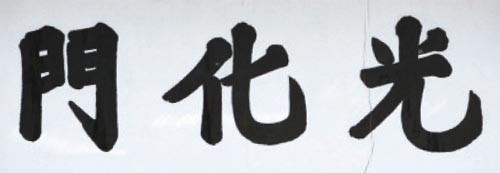In signboard debate, wood is the focus

A crack on the signboard of Gwanghwamun, the gate to Gyeongbok Palace, has sparked a debate over who is to blame. [NEWSIS]
Ever since a small crack on the signboard of Gwanghwamun was noticed earlier this month, a debate has arisen over who is to blame, especially because the Cultural Heritage Administration, which was in charge of the restoration project, has not yet affirmed its official stance on the matter.
Choi Moon-soon, a lawmaker with the main opposition Democratic Party, said in a statement yesterday that the signboard must have been made of ordinary pine instead of the high-quality Geumgangsong pine that Shin Eung-soo, the head carpenter who directed the Gwanghwamun reconstruction project, said he had used.
But Shin immediately refuted the statement, telling the reporters that anyone who makes a statement like that does not know how to evaluate the quality of wood.
“If they are so curious, why don’t they remove the signboard and examine it in person?” he said.
The signboard was created as part of a larger project to restore Gwanghwamun, the main gate of Gyeongbok Palace. The CHA completed the restoration process in mid-August, about four months ahead of schedule, so that the gate could be unveiled in time for the 100th anniversary of Korea’s annexation to Japan on Independence Day (Aug. 15) and for the G-20 Summit in Seoul last week.
When the crack was found, the CHA said in a press release on Nov. 4 that the Korean pine used for the signboard “normally has contractions and expansions,” which leads to “minor cracks in dry autumn weather like this.”
But Kim Jong-wook, a Gyeonggi Intangible Cultural Heritage-designated expert in dancheong, the multicolored paint work found in palaces and temples, disagrees.
“If properly dried, the pine would have not cracked. It cracked because the restoration process was pushed to meet the early opening schedule,” Kim said.
Critics are putting most of the blame on Shin, who provided the wood, and Oh Ok-jin, director of letter carving, who was responsible for putting the finishing touches on the signboard.
They blame Shin for not drying the wood properly, but they also blame Oh for not being able to tell whether the wood was completely dry or not. Shin says that he dried the wood for more than three years before handing it over to Oh.
“No matter what the reasons are or who is responsible for the crack, as the head carpenter I feel responsible,” said Shin.
He said he is determined to see the signboard fixed, even if he has to do it himself.
“I will restore the signboard with my own money,” Shin said.
The CHA has been cautious in responding to the criticism and is evaluating its options.
“It’s much more important to examine why the crack appeared in the first place,” said Park Young-geun, director of the agency’s cultural heritage restoration department. “We will decide whether to change the signboard after the results come out.”
By Lee Sun-min [summerlee@joongang.co.kr]










with the Korea JoongAng Daily
To write comments, please log in to one of the accounts.
Standards Board Policy (0/250자)